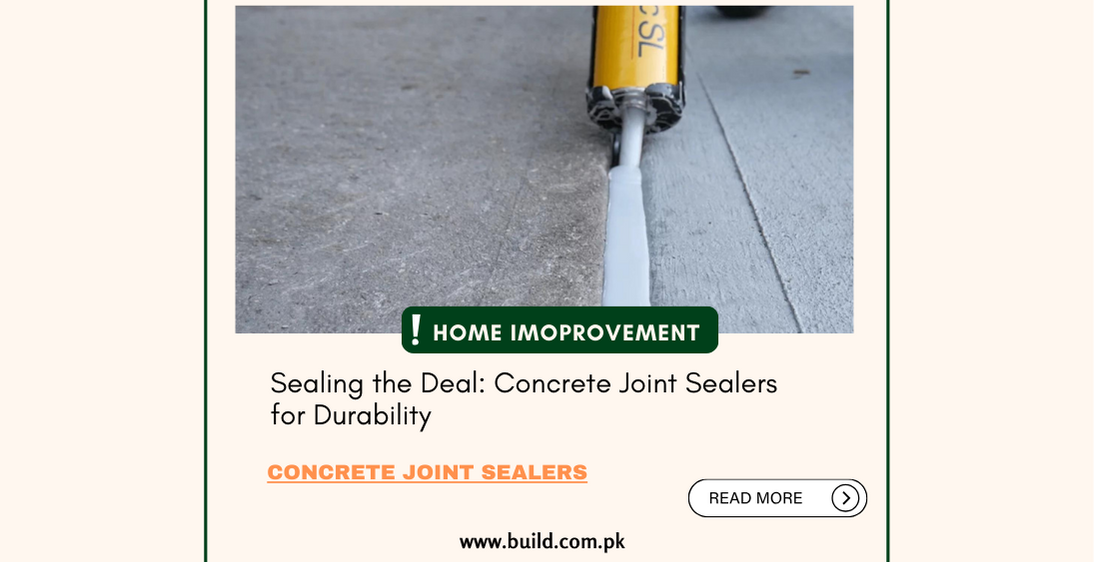Sealing the Deal: Concrete Joint Sealers for Durability

Introduction:
Concrete joint sealers play a crucial role in preserving the
integrity and longevity of concrete structures by providing a protective
barrier against moisture, chemicals, and other environmental elements. In this
comprehensive blog, we delve into the world of concrete joint sealers,
exploring their importance, types, applications, benefits, and considerations
for selecting the right sealer for various concrete projects.
Understanding Concrete Joint Sealers:
Concrete joint sealers, also known as sealants or caulking
compounds, are materials applied to joint, gaps, or cracks in concrete
structures to prevent the ingress of water, chemicals, debris, and other
contaminants. These sealers serve as a barrier that seals the joints, maintains
structural integrity, and prevents deterioration due to moisture infiltration,
freeze-thaw cycles, and chemical exposure.
Importance of Concrete Joint Sealers
Waterproofing:
Concrete joint sealers effectively waterproof
joints and cracks in concrete structures, preventing water infiltration and
moisture-related damage such as spalling, cracking, and corrosion of
reinforcement.
Durability:
By protecting concrete joints from moisture,
chemicals, and abrasion, sealers enhance the durability and service life of
concrete structures, reducing the need for costly repairs and maintenance over
time.
Aesthetic Enhancement:
Sealers can improve the appearance of
concrete surfaces by filling voids, smoothing rough edges, and enhancing color
uniformity, resulting in a more aesthetically pleasing finish.
Structural Integrity:
Properly sealed joints contribute to
the structural integrity of concrete structures by preventing the ingress of
water and contaminants that can compromise the stability and load-bearing
capacity of the structure.
Types of Concrete Joint Sealers
Silicone Sealers:
Silicone sealers offer excellent
flexibility, adhesion, and weather resistance, making them suitable for
expansion joints, control joints, and vertical surfaces. They are resistant to
UV exposure, temperature fluctuations, and chemical exposure.
Polyurethane Sealers:
Polyurethane sealers provide superior
durability, abrasion resistance, and flexibility, making them ideal for
high-traffic areas, parking decks, and industrial floors. They can accommodate
joint movement and offer excellent adhesion to concrete substrates.
Acrylic Sealers:
Acrylic sealers are water-based sealants
that offer good adhesion, UV resistance, and color retetion. They are suitable
for decorative concrete surfaces, stamped concrete, and exposed aggregate
finishes.
Epoxy Sealers:
Epoxy sealers provide a high-gloss finish,
excellent chemical resistance, and durability, making them ideal for industrial
floors, garage floors, and chemical containment areas. They offer superior
adhesion to concrete substrates and can withstand heavy traffic and harsh
environments.
Applications of Concrete Joint Sealers
Concrete joint sealers are used in various applications,
including:
Expansion Joints: Sealing expansion joints in concrete slabs,
bridges, and highways to accommodate movement and prevent water infiltration.
Control Joints: Sealing control joints in concrete pavements,
sidewalks, and floors to control cracking and maintain structural integrity.
Vertical Joints: Sealing vertical joints in concrete walls,
retaining walls, and precast panels to prevent water penetration and protect
against freeze-thaw damage.
Decorative Concrete: Sealing decorative concrete surfaces
such as stamped concrete, exposed aggregate, and colored concrete to enhance
appearance and protect against staining and abrasion.
Considerations for Selecting Concrete Joint Sealers
Joint Type and Width: Consider the type and width of the
joint or crack to be sealed, as different sealers are designed to accommodate
specific joint sizes and movements.
Traffic and Usage: Determine the level of traffic and usage the concrete surface will experience, as this will influence the type of sealer required (e.g., high-traffic areas may require more durable sealers).
Environmental Conditions: Consider the environmental
conditions, including temperature fluctuations, UV exposure, and chemical
exposure, to select a sealer that offers suitable resistance and performance.
Aesthetic Requirements: If aesthetics are important, consider
the desired finish (e.g., gloss, matte) and color options available with
different sealers.
Benefits of Using Concrete Joint Sealers
Waterproofing: Concrete joint sealers provide effective
waterproofing, preventing water infiltration and moisture-related damage to
concrete structures.
Durability: Sealers enhance the durability and longevity of
concrete structures by protecting against moisture, chemicals, and abrasion.
Ease of Maintenance: Sealed joints are easier to clean and
maintain, reducing the need for frequent repairs and maintenance.
Cost Savings: By preventing damage and deterioration, sealers
help extend the service life of concrete structures, resulting in cost savings
over time.
Conclusion:
In conclusion, concrete joint sealers are essential
components of concrete construction projects, offering protection, durability,
and longevity to concrete structures. By understanding the importance, types,
applications, considerations, and benefits of concrete joit sealers,
construction professionals can make informed decisions and select the right
sealer for their specific project requirements. Whether sealing expansion
joints in bridges, control joints in pavements, or decorative concrete
surfaces, choosing the right sealer plays a crucial role in ensuring the
performance and longevity of concrete structures for years to come.









